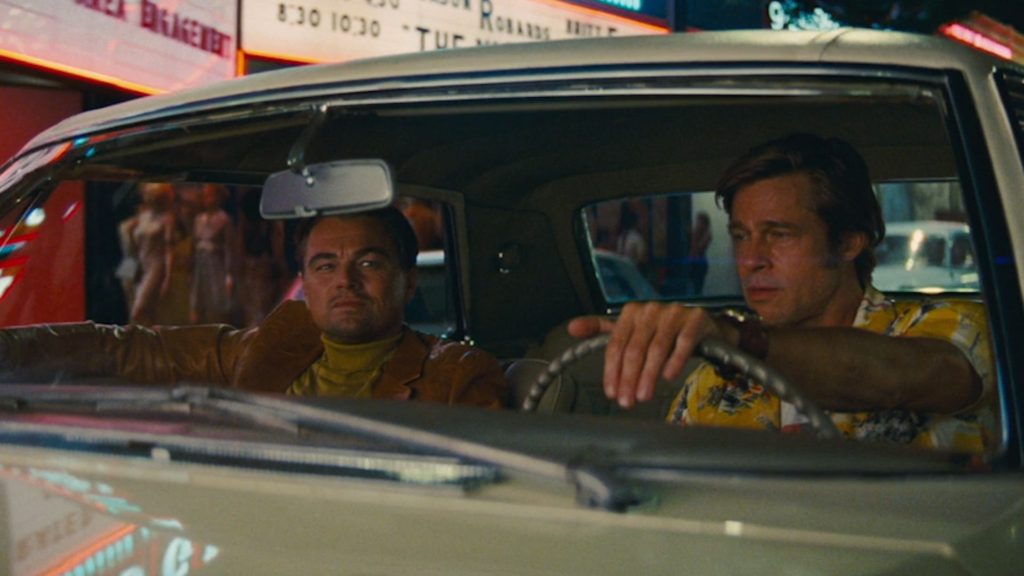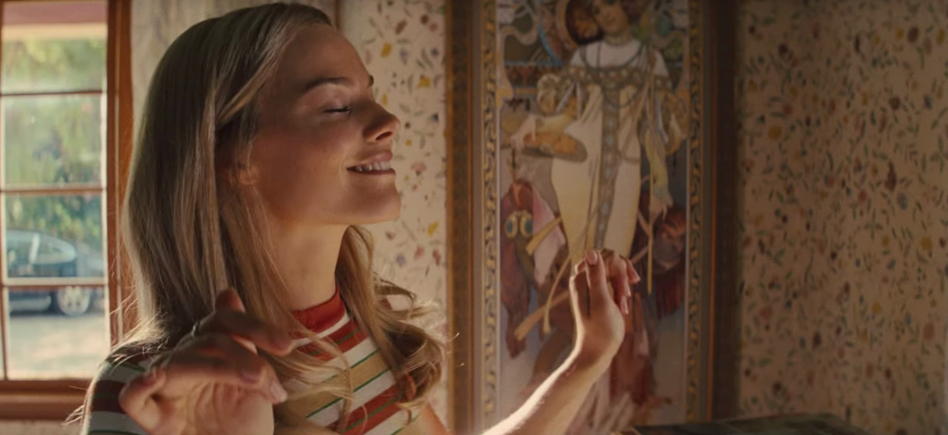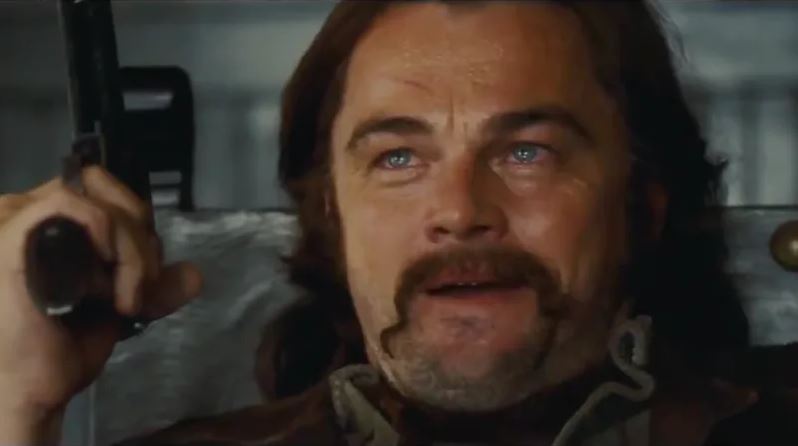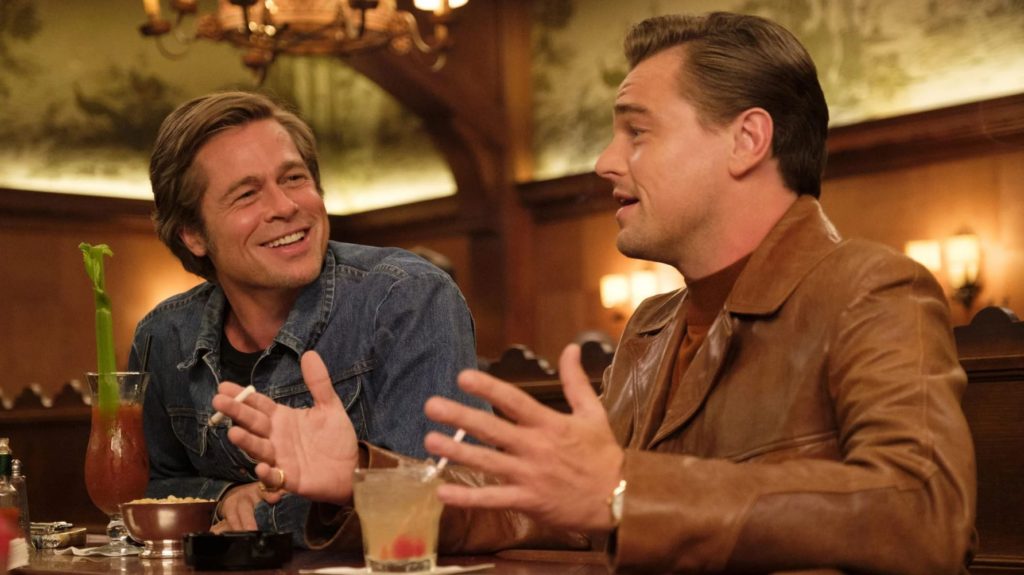
During one of the many enjoyably languorous stretches in Once Upon a Time in Hollywood, a woman buys a ticket to a movie. Told that the price is 75 cents—one of a million quaint signifiers that this film takes place in 1969—she haggles with the ticket taker, asking if she might receive a discount on account of being in the movie. After proving that she is indeed the picture’s third-billed actor—and after posing for a photo next to its poster—she gains free admittance to the theater, where she skittishly sinks into her seat and dons a pair of giant hoop glasses, eyes darting around the crowd in the sweet, vaguely desperate hope that her fellow patrons might appreciate her performance.
The woman is Sharon Tate, and Once Upon a Time in Hollywood, the bold and beautiful and surprisingly moving new film from Quentin Tarantino, is in some ways about her grisly murder at the hands of the Manson Family. But it is also very much not about that. It is, more principally, a movie about its maker’s love of movies. And while, physically speaking, few would confuse Tarantino with Margot Robbie—the actress who here plays Tate with fizzy, wistful adorability—it’s possible to view Tate as a surrogate for the director, a man who takes immense pride in his work and who also craves validation for his craft.
This time, he’s earned it. Once Upon a Time in Hollywood is one of Tarantino’s best movies, a strange and thrilling experience that is somehow pleasurable, forceful, and tender all at once. Arguably history’s most celebrated film geek—lest you forget, he used to work in a video store—Tarantino loads each of his pictures with countless allusions to the cinema of yore, and setting his latest adventure during Tinseltown’s golden age only grants him even greater license to flaunt his encyclopedic knowledge. Yet thanks to its creator’s dynamic execution and extraordinary nerve, Once Upon a Time in Hollywood transcends mere homage. Even as it pays constant tribute to the past, it stands confidently as its own monumental achievement in the present.

Its central characters, on the other hand, find themselves stumbling on the downslope. Rick Dalton (a fabulous Leonardo DiCaprio) was once the glamorous star of a popular TV western called Bounty Law, but while he subsequently appeared in a few feature films, his career has tapered off to the point where he’s now typecast as the heavy in gunslinger procedurals. He’s also a drunk, which is why he’s chauffeured around by his best friend and stuntman, Cliff Booth (Brad Pitt, very fine and still fine), a disgraced veteran whose shady past has turned every gaffer in town against him. But while Rick and Cliff may be down on their professional luck, they at least have each other, and their easy partnership fits snugly within the rich history of fraternal loyalty scattered across Tarantino’s catalog. Watching these two has-beens slide into a lemon-yellow Coupe de Ville and desultorily head off to work, it’s hard not to think of John Travolta and Samuel L. Jackson gabbing about the metric system and the royale with cheese on their way to do some casual killing in Pulp Fiction.
And to be sure, Once Upon a Time in Hollywood—you will forgive me if I ignore the ellipsis that technically separates the title’s final two words—is very much A Quentin Tarantino Movie, replete with his usual tics and flourishes. There are sequences of sustained tension that threaten to erupt in ghastly violence. There are innumerable references to pop-culture artifacts, both in plain sight and lingering in the background. There is an intimate and thorough appreciation of Los Angeles: its mood, its citizenry, its geography. There are familiar faces in bit parts, including Kurt Russell, Michael Madsen, and Zoë Bell. There are lots of shots of women’s feet.
Yet where his recent work has sometimes verged on the familiar—as entertaining as The Hateful Eight was, it often scanned as Reservoir Dogs: Old West Edition—Once Upon a Time in Hollywood never feels repetitive or conventional. Eschewing the rigid chapter format he typically favors, Tarantino constructs the movie as a limber, freewheeling odyssey into a bygone era, a land of muscle cars and spaghetti westerns and harmless debauchery. Rather than preoccupying himself with building suspense, he allows himself and his characters to luxuriate, resulting in a wonderfully relaxed vibe. There are inevitably moments of excess—a sequence of Cliff cruising down LA’s boulevards runs longer than it needs to, though a follow-up scene of him patiently feeding his impeccably trained pit bull slyly acquires retroactive narrative importance—but the film’s sense of sprawl is generally enveloping. The body count is also far lower than usual; rather than startling you with death, Tarantino seduces you with beauty.

Or maybe it’s that most of the deaths are fake. Hollywood devotes a surprising amount of time to Rick’s acting career, routinely disappearing inside the dusty back lots and flimsy sets where he plies his trade, most notably on a new series called Lancer. Beyond allowing Tarantino to import some overqualified character actors to deliver some deliciously hard-boiled dialogue—Rick’s sparring partners include Timothy Olyphant, Scoot McNairy, and the late Luke Perry—this recursive, show-within-a-show approach permits him to more directly explore one of his favorite topics: the movies. It’s easy to mock old motion pictures—a spry Al Pacino shows up early on to give us a brief, hilarious tour of Rick’s work in jingoistic war films—but Tarantino’s affection for his medium is undeniably sincere. Much like Death Proof postured itself as a parody of grindhouse exploitation flicks before sneakily turning into a propulsive thriller, the Lancer scenes here pulse with legitimate energy and skill. The false fronts and cheap whiskey become their own kind of valentine.
Lancer may be soundly old-fashioned, but Hollywood is decidedly modern, with Tarantino bringing his usual filmmaking verve to bear. He can be showy on occasion here, especially early on, with lots of quick-hitting editing and flashy music. But as the movie progresses, his style grows more elegant and immersive, calibrating itself to match the leisurely pacing and hospitable atmosphere. Working again with venerated cinematographer Robert Richardson, Tarantino lights many of the exterior scenes in a golden glow, with playful low-angle framing and seamless match cuts. One particular shot, in which the camera begins up on Rick’s roof and then gradually floats downward before alighting on a car departing the neighboring house, is a virtuoso display of effortless precision.
It helps, of course, when you cast one of the most gifted actors in the world. On the set of Lancer, Rick finds himself conversing with eight-year-old Trudi (Julia Butters, a born scene-stealer), a dedicated thespian who postulates that actors can never achieve their platonic ideal of 100% truth. She must never have seen DiCaprio work. His performance as Rick is another marvel, funny and jagged and unpredictable and remarkably heartfelt. A scene of Rick alone in his trailer, where he furiously berates himself for his sloppy work on set, is a hysterical display of self-loathing that camouflages a deep-seated fear of his own obsolescence. But that’s just the most colorful point in DiCaprio’s kaleidoscopic portrayal, which accumulates small gestures—a stutter here, a smile there—and piles them into a comprehensive creation of a man who’s simultaneously proud and broken. Rick Dalton is a thoroughly ridiculous character. DiCaprio turns him into a man.

There are other, more powerful men in Rick’s orbit, celebrities whom Tarantino gives a sliver of screen time, as though we’re hurtling through time on a Hollywood Hills tour bus. And so we get to see Sharon Tate’s husband, Roman Polanski (Rafal Zawierucha), who just happens to live next door to Rick. Steve McQueen (Damian Lewis), who beat out Rick for the lead role in a little movie called The Great Escape, pops up at a party to explain Sharon’s quasi-love triangle with Polanski and the famous hair stylist Jay Sebring (Emile Hirsch). And the dragon himself, Bruce Lee (Mike Moh), makes an agreeably cocky appearance, tussling with Cliff on the set of The Green Hornet. (Speaking of Cliff, Pitt gives his best performance in some time, and he proves a far more natural second fiddle here than he was in Inglourious Basterds; his line reading of “Naw, it was dumber than that” is perhaps the film’s most uproarious moment.)
But the most significant of these household names—the man who casts a long and terrible shadow, whose specter looms over everyone and everything—is Charles Manson.
To my recollection, Manson’s surname is never spoken aloud in Hollywood, and we see him only once, when he cheerfully knocks on the door of Sharon’s house and then leaves without incident. (He’s played by Damon Herriman, best known as Dewey Crowe, Olyphant’s perpetual and pathetic punching bag on Justified; he’ll be appearing as Manson again in the second season of Netflix’s Mindhunter.) But anyone with even a cursory knowledge of what happened in Los Angeles in August 1969 will find themselves flinching whenever a hippie mentions “Charlie”, and wincing when Sharon heads to a bookstore to buy a copy of Tess of the d’Urbervilles.
Manson’s invisible presence in the film produces curious effects. To begin with, it allows Tarantino to slowly infuse Hollywood with tension, a classical horror-movie dread. This is most apparent during a protracted, expertly orchestrated sequence where Cliff picks up a teenage hitchhiker (Margaret Qualley, confirming once again that she should be in everything) and takes her to a remote ranch, which he finds overrun by an armada of long-haired, free-loving youths. The set piece that follows—featuring appearances from Dakota Fanning, Bruce Dern, and Euphoria’s Sydney Sweeney—is one of the film’s most traditionally Tarantinoesque scenes, which means that it’s a masterful exercise in gathering suspense and hinting at points of danger.
By all rights, this suffocating intensity should be at odds with Hollywood’s gentle, laid-back demeanor. Yet Tarantino somehow marries these disparate tones, weaving them into a cohesive tapestry whose full, complex design isn’t revealed until the movie’s stunning finale.
About which, well, I can only divulge so much. Suffice it to say that the climax of Once Upon a Time in Hollywood is something special, a tour de force of thematic richness and bravura brutality. On a nuts-and-bolts level, it’s blistering entertainment, a glorious catharsis full of gushing blood and cauterizing fire. But it also operates at a dimension that’s nigh spiritual. As he did in Basterds, Tarantino indulges his audacious penchant for historical revisionism, and in the process, he bares his soul.
Quentin Tarantino doesn’t just love movies; he believes in them. And while that might make him—much like a cinematic icon from a different decade—a rank sentimentalist, there’s something deeply romantic about his passion, the idea that art has the power to heal us and protect us. Maybe that’s facile; after all, movies can’t change history. But when they’re made like this, with such craft and conviction, they can change people, and maybe even the world.
Grade: A-
Jeremy Beck is the editor-in-chief of MovieManifesto. He watches more movies and television than he probably should.
